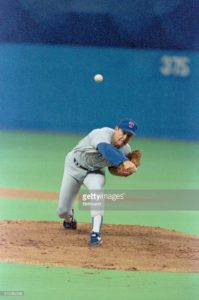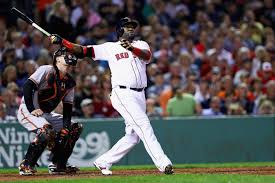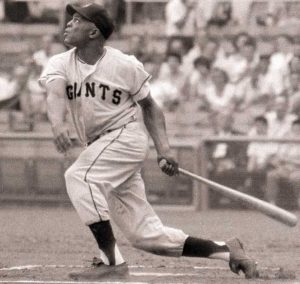“Hit it where they ain’t” – Willie Keeler
Batting
Some things never change. Keeler’s advice (of which he was a master) is unchanged: The goal of the batter is to hit the ball such that it can’t be readily caught by a defensive player.

What the batter sees; the pitcher is Nolan Ryan, so that ball is coming at over 100 mph.
The pitcher throws the ball. The batter chooses to swing at the ball, or not to swing. Given that the ball is thrown at 80-100 mph, from 60 1/2 feet away 1 2 with uncertain trajectory or spin, it is amazing a batter can hit a baseball at all. The batter is watching the pitcher’s arm, tracking the course and spin of the ball in-flight, swinging the bat where he hopes the ball will be, and (believe it or not) trying to aim the ball!
If the batter swings and misses the ball, that is a strike. If the pitch is deemed by the umpire to be within the strike zone, which is: horizontally, over the plate, vertically, roughly between knee and chest level, and the batter does not swing, that is also a strike: a called strike. If a batter accumulates three strikes, he is “out”: a strikeout, or K. If a pitch is outside the strike zone, and the batter does not swing, that is a ball; if a batter accumulates four balls, he proceeds to first base: this is a walk, or base on balls (BB). If a batter hits the ball, but into foul territory, this counts as a strike (with one exception: a foul after two strikes does not count as the third strike; in fact, a batter can hit an endless number of foul balls)(but with one exception to the exception: a foul ball on a bunt attempt indeed counts as the third strike)(but with a further exception: a “foul tip” after two strikes, which is a ball that is just barely hit, so that the trajectory is not substantially altered, is in fact, a third strike, as long as the catcher catches it)(but, and this is important: after ANY third strike that the catcher is not able to catch, the batter is free to run to first base! 3 He is still considered to have been struck out, but, especially if the ball gets away from the catcher, the batter may well end up as a baserunner…or worse!) 4
And I apologize for the length of the preceding segment on foul balls. There will be no more of that. 5

David Ortiz launches a home run
If a ball is hit
There are four basic trajectories a batted ball may take.
1. Ground ball. Usually caught by the infielders, thrown to the first baseman, he touches the base, batter is out if he hasn’t reached the base before the ball gets there. 6 7 But sometimes a batter will hit a ground ball between all the infielders; this will be a clean base hit.
2. Fly ball. Lofted into the air. If hit hard enough, it may fly all the way out of the playing field, in fair territory: a home run! The batter runs all the way around the bases, and runners already on base precede him; each scores a run. If the bases are loaded, ie runners at all three bases, that is a four-run homer: a grand slam. If not hit so hard, usually caught by an outfielder. The batter is out, and baserunners…we will cover this in the baserunning section.
3. Line drive: a ball hit on a flat or slightly upward trajectory. What most batters want. If low, may be snagged on-the-fly by an infielder, which is an out (just like a fly ball), but often goes over the infielders. Outfielders have little time to react, so unless hit very near one of them, usually a base hit.
4. Pop-up. A ball that is hit from underneath; goes high in the air, with ferocious backspin; usually caught by an infielder or catcher.
 Willie Mays hits a home run.
Willie Mays hits a home run.
Hits
1. Single. The most common hit. The batter gets as far as first base. Baserunners get…wherever they can, in the time they have (usually not far). A ground ball through the infield, a line drive hit toward, but short of, the outfield: these are typical singles. Occasionally a batter will hit a ball so slowly that it stays in the infield, but the batter (usually a fast runner) gets to first base before the infielders can get ball there: an infield single. A single to the outfield will usually score (allow to reach home plate) a runner at second or third, which is why baserunners at those bases are said to be in “scoring position”.
2. Double. Usually a line drive or fly ball between the outfielders, or (especially in Fenway Park, with its “monstrous” left field wall, the Green Monster) ricocheted off the wall. A baserunner on first base will often score on a double. A ball that bounces out of the field (usually in the outfield) is a ground rule double; the batter goes to second base, and baserunners advance two bases. 8
5. Triple. The rarest hit. Needs to be between/past the outfielders, or “buried in the corner” in left or right; typically, only fast runners will hit triples.
4. Home run. A fly ball out of the playing field in fair territory.
5. Inside-the-park home run. The rarest of all. This is basically a four-base hit, or a triple-plus. Usually only occurs when the outfielders are fooled by a weird bounce or something, and with a very fast batter.
A right-handed batter stands at the left side of the plate, with bat over right shoulder. A left-handed batter does the reverse. (David Ortiz, in the picture, is a lefty). Some players are capable of hitting well from either side; they are switch-hitters. The reason why this would be useful will be in the “pitching” section.
Other ways to reach base
The error: if a fielder fails to make a catch that (in the opinion of the official scorer) he should have made, or makes a bad throw to another defender, and the batter is able to reach base, the fielder is charged with an error, and the batter is safe. 9 When a player’s batting average is computed, reaching base on an error counts as though he made an out. Nobody likes to see errors in a game; players and fans alike like to see a “clean” game, but if an error is made, we all hope it is the other team’s!
The fielder’s choice: if a runner is at first base, and the batter hits a ground ball, the infielder will field it, and throw to second base to force-out the runner that started at first. If there is time, the second baseman will then throw to first base, and maybe get the batter out at first as well: a double play. But there may not be time, and the batter may reach first base safely. This is called a fielder’s choice: the batter could have been thrown out at first, but the infielder chose to force the runner out at second instead. Again, this counts on the batter’s average as though he made an out.
Hit batsman, or hit-by-pitch: self-explanatory. The batter is awarded first base, just like a walk. Assuming he is not injured. 10
Catcher interference: if the catcher’s mitt touches the hitter’s bat, even inadvertently, the batter is awarded first base.
Where will the ball go?
The greatest power in a bat-swing occurs as the bat passes the plate; thus, right handed batters hit harder to left field, and lefties hit harder to right. This is known as pulling the ball; the strongest home-run hitters typically are pull-hitters. A hit in the other direction (left field for a lefty, etc) is known as hitting to the opposite field, or the other way. A batter that can do either, well, keeps the defense more spread out; against a known pull-hitter, they can bunch up on the appropriate side. More on this in the section on fielding.
Now what?
Now you are on base…what now? The next section will be baserunning. Stay tuned!
- Less, really, because the pitcher is moving forward while throwing, with only his back foot required to be at the “rubber”, 60 1/2 feet from home plate.
- I agonized over whether I could write this blog avoiding gender-specific pronouns. I have failed, mostly due to laziness, but also because I am a simple blogger, and this were best left to professionals. If only that self-appointed guardian of the language, William Safire, were still with us: he could refute me, a cultural maelstrom would ensue, and the language would be forced to adapt (see Safire’s columns about the honorific “Ms”.)
- Assuming first base is “empty”.
- Usually, after a dropped third strike, the ball is lying on the ground in front of the catcher, and he can just pick it up and tag the batter…or throw to first, where, since the batter is forced to first, the first baseman need only touch the base.
- Yes, there will. A ground ball is foul if it is in foul territory when it passes first base or third base. I fly ball is foul if it is in foul territory when it lands, or (if hit over the outfield wall) when it passes the foul pole.
- If the ball is fielded by the first baseman, it is the pitcher’s job to run to first base to receive the throw. The pitcher is an infielder once the pitch is thrown!
- First base is unique, in that the batter is allowed to overrun first base; he does not have to stop there, but can let his momentum continue until he has passed the base…as long as he does not start movement toward second base!
- This sucks when the offense has a runner at first base; as previously mentioned, that runner would have a decent chance to score on a double, but on a ground rule double, he only advances to third base.
- Note: no harm, no foul! If no offensive player benefits from the mistake, ie does not advance to a base they would otherwise not have reached, there is no error.
- Which happens, sometimes seriously. The Red Sox, in the ’60’s, had a phenomenal young right fielder named Tony Conigliaro, whose career was ruined by a pitch to the face, shattering orbital bones.
